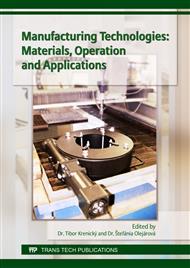p.88
p.96
p.107
p.119
p.127
p.136
p.142
p.149
p.155
Issue of Design Gate Dimensions and Experimental Assessment of the Suitability of Analytical Design
Abstract:
From the point of view of its design solution, the shape, the dimensions and the position of an gate have the biggest impact on the final quality of castings. The gate is where the stream of hot-melt flowing into the mould cavity is modulated, and where the speed of this stream changes, which eventually determines the loading mode of the mould cavity affecting the homogeneity of any casting, and thus its mechanical properties as well. The length of the gate for a specific type of casting is determined constantly according to the projection methodology for connecting the gate to the casting. The gate height is determined by its area to length ratio. In practice, several methods are used to determine the gate area. The presented paper deals with an assessment of particular methods of designing the gate area for a specific type of a lightweight casting on the basis of silumin produced, using die casting technology. Since the length of the gate is constant, based on particular methods for determining the area, the gate height is the variable parameter. The performed experiments focus on an assessment of permanent deformation of parts cast at certain gate heights, determined analytically according to particular calculation methods. Permanent deformation serves as an indicator of the most suitable method for the gate area calculation. At the same time, the paper specifies patterns required for the calculation of gate dimensional characteristics, since the available scientific literature only provides indicative values depending on the nature of any given casting or an alloy.
Info:
Periodical:
Pages:
142-148
Citation:
Online since:
September 2017
Authors:
Keywords:
Price:
Сopyright:
© 2017 Trans Tech Publications Ltd. All Rights Reserved
Share:
Citation:


